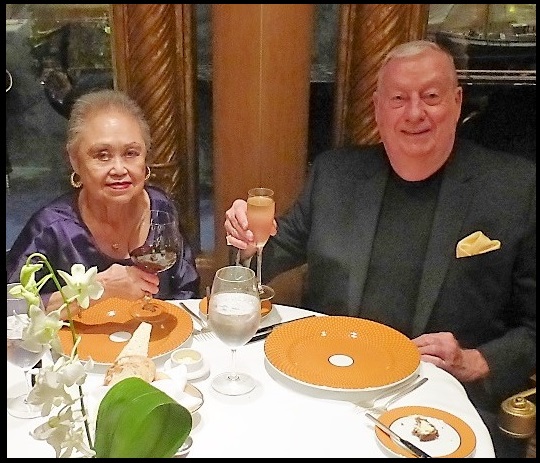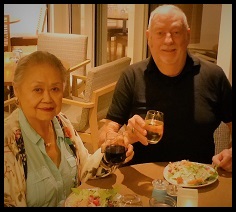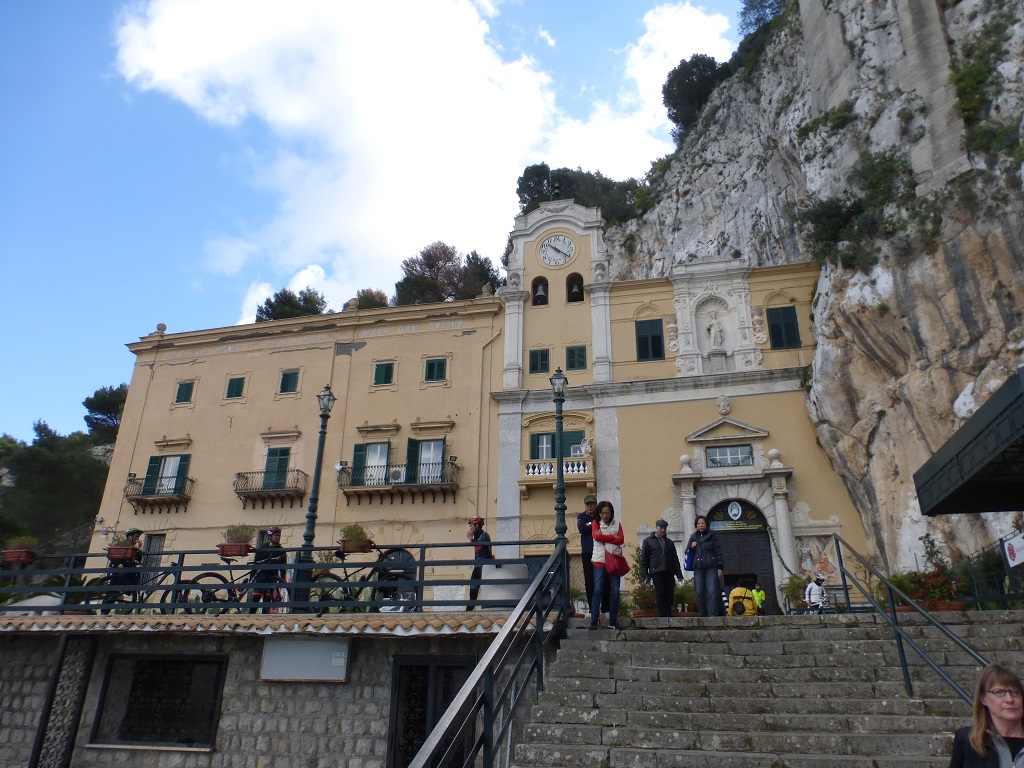


 |
 |
 |
|
Celebrating Chuck's 78th Birthday in Sicily! |
I celebrated my 78th birthday in Sicily at the Chefs Table on the Viking Star. My friend Virginia took me to the dinner and ordered champagne for us to start out our dining experience. This is fine dining at it's best. Check us out and the menu featuring and photos of each dish we had along with the best wine associated with each course. We were lucky enough afterwards, to get a second invite later in the week for the Chinese dining experience!
A Gastronomic Journey throught Time
Planning my 78th Birthday in Sicily
Because of its strategic location, Sicily was invaded over the centuries by many armies, and was once the site of Roman, Greek and Phoenician colonies. For history-buffs and interested tourists, remnants of those cultures remain to this day.
As the Roman Empire fell apart, a Germanic tribe known as the Vandals overpowered Sicily in 440 AD under the ruling of King Geiseric. They were a short lived kingdom, as the Byzantine Empire pushed their way in by the late 400's.
The Byzantine's used Sicily as a base to conquer the rest of Italy, and ultimately the capital of the empire was moved to Syracuse, Sicily in 663.
Defeated by the Arabs in 965, land reforms were initiated, and an increase in productivity on the island encouraged growth. Under the ruling Arabs, native Christians were given freedom of religion, however, they had to pay a tax, and were greatly limited in their occupations, dress and participation in public affairs.
*** Check out the web site at Travel Planning by Viviane for the latest updates on traveling. ***
This link will display an overview of the itinerary and information on the Viking Star cruise ship we are sailing on the Mediterranean Sea.
The population of Palermo urban area is estimated by Eurostat to be 855,285, while its metropolitan area is the fifth most populated in Italy with around 1.2 million people. In the central area, the city has a population of around 676,000 people. The inhabitants are known as Palermitani or, poetically, panormiti. The languages spoken by its inhabitants are the Italian language and the Palermitano dialect of the Sicilian language.
Palermo is Sicily's cultural, economic and tourism capital. It is a city rich in history, culture, art, music and food. Numerous tourists are attracted to the city for its good Mediterranean weather, its renowned gastronomy and restaurants, its Romanesque, Gothic and Baroque churches, palaces and buildings, and its nightlife and music. Palermo is the main Sicilian industrial and commercial center: the main industrial sectors include tourism, services, commerce and agriculture. Palermo currently has an international airport, and a significant underground economy. In fact, for cultural, artistic and economic reasons, Palermo was one of the largest cities in the Mediterranean and is now among the top tourist destinations in both Italy and Europe. It is the main seat of the UNESCO World Heritage Site Arab-Norman Palermo and the Cathedral Churches of Cefalů and Monreale. The city is also going through careful redevelopment, preparing to become one of the major cities of the Euro-Mediterranean area.
This moutain is right by Palermo and is about 1,500 feet tall. It has fantastic views and on the top is the building holding the remains of the saint who saved Palermo from the plague, Saint Rosalia!
In the distance on the water between the hills is a small island and of all people, Joe Dimaggio's parents lived there!
Rosalia was born of a Norman noble family that claimed descent from Charlemagne. Devoutly religious, she retired to live as a hermit in a cave on Mount Pellegrino, where she died alone in 1166. Tradition says that she was led to the cave by two angels. On the cave wall she wrote "I, Rosalia, daughter of Sinibald, Lord of Roses, and Quisquina, have taken the resolution to live in this cave for the love of my Lord, Jesus Christ."
In 1624, a plague beset Palermo. During this hardship Saint Rosalia appeared first to a sick woman, then to a hunter, to whom she indicated where her remains were to be found. She ordered him to bring her bones to Palermo and have them carried in procession through the city.
The hunter climbed the mountain and found her bones in the cave as described. He did what she had asked in the apparition. After her remains were carried around the city three times, the plague ceased. After this Saint Rosalia was venerated as the patron saint of Palermo, and a sanctuary was built in the cave where her remains were discovered.
We drove along the beautiful beach and visited this strange looking building!
We were told the Belgiums and an Italian company bought the land and made it a private beach. The companies are in the realty business and decided to put in a beach made from of all places, sand from Belgium. Why there when so much sand is available in Italy and Africa? The building has the Italian flag and the Belgium flag flying over it! Very strange!
Palermo Cathedral is the cathedral church of the Roman Catholic Archdiocese of Palermo, located in Palermo, Sicily, southern Italy. It is dedicated to the Assumption of the Virgin Mary. As an architectural complex, it is characterized by the presence of different styles, due to a long history of additions, alterations and restorations, the last of which occurred in the 18th century.
The church was erected in 1185 by Walter Ophamil (or Walter of the Mill), the Anglo-Norman archbishop of Palermo and King William II's minister, on the area of an earlier Byzantine basilica. By all accounts this earlier church was founded by Pope Gregory I and was later turned into a mosque by the Saracens after their conquest of the city in the 9th century. Ophamil is buried in a sarcophagus in the church's crypt. The medieval edifice had a basilica plan with three apses, of which only some minor architectural elements survive today.
The upper orders of the corner towers were built between the 14th and the 15th centuries, while in the early Renaissance period the southern porch was added. The present neoclassical appearance dates from the work carried out over the two decades 1781 to 1801, and supervised by Ferdinando Fuga. During this period the great retable by Gagini, decorated with statues, friezes and reliefs, was destroyed and the sculptures moved to different parts of the basilica. Also by Fuga are the great dome emerging from the main body of the building, and the smaller domes covering the aisles' ceilings.
Street Scene
Black Market Sunday - Businesses supposedly not open for business!
Old Fortress Wall
Opera House
When Napolean invaded Naples he ran the King out of the city. The King escaped to Palmero and the locals were excited to have the King living among them. To show their gratitude, they offered him land to hunt on. He decided to build a lodge and in the style that then was sweeping the continent, the Chinese Style.
The end of a great day having my 78th Birthday Dinner on the Viking Star and the Chefs Table with Virginia!
Our first trip was to Ireland and we also traveled on my birthdays to Jamaica, Indonesia and now Sicily!





As you can see, I have traveled all over the world and at times, tried to coordinate my birthday with a new country or city to visit. Since my birthday is on February 4th, many places I would like to visit are too cold so it would be difficult to travel and take photos. I decided to try some place where the weather might warm enough to enjoy my birthday. Maybe lots of champagne will be needed!

Day 3 - History and Map of Sicily
S
icily is Italy's largest island and the largest island in the Mediterranean Sea. It's also a geographical and political region of Italy, famed for its beautiful beaches, cuisine, and fascinating history.

My Personal Travel Agent - Setting up trips to Portugal and many other destinations. A top Travel Consultant.

Departure Lounge Travel Agency
Viviane Tondeur MBA, CTC, DS

vtondeur@departurelounge.com
818-268-6552
Viking Star Overview
Sicily (Palermo), Italy
Palermo
Palermo is a city of Southern Italy, the capital of both the autonomous region of Sicily and the Metropolitan City of Palermo. The city is
 noted for its history, culture, architecture and gastronomy, playing an important role throughout much of its existence; it is over 2,700 years old. Palermo is located in the northwest of the island of Sicily, right by the Gulf of Palermo in the Tyrrhenian Sea.
The city was founded in 734 BC by the Phoenicians as Ziz ('flower'). Palermo then became a possession of Carthage, before becoming part of the Roman Republic, the Roman Empire and eventually part of the Byzantine Empire, for over a thousand
years. The Greeks named the city Panormus meaning 'complete port'. From 831 to 1072 the city was under Arab rule during the Emirate of Sicily when the city first became a capital. The Arabs shifted the Greek name into Bal'harm, the root for Palermo's present-day name. Following the Norman reconquest, Palermo became the capital of a new kingdom (from 1130 to 1816), the Kingdom of Sicily and the capital of the Holy Roman Empire under Emperor Frederick II and King Conrad IV.
noted for its history, culture, architecture and gastronomy, playing an important role throughout much of its existence; it is over 2,700 years old. Palermo is located in the northwest of the island of Sicily, right by the Gulf of Palermo in the Tyrrhenian Sea.
The city was founded in 734 BC by the Phoenicians as Ziz ('flower'). Palermo then became a possession of Carthage, before becoming part of the Roman Republic, the Roman Empire and eventually part of the Byzantine Empire, for over a thousand
years. The Greeks named the city Panormus meaning 'complete port'. From 831 to 1072 the city was under Arab rule during the Emirate of Sicily when the city first became a capital. The Arabs shifted the Greek name into Bal'harm, the root for Palermo's present-day name. Following the Norman reconquest, Palermo became the capital of a new kingdom (from 1130 to 1816), the Kingdom of Sicily and the capital of the Holy Roman Empire under Emperor Frederick II and King Conrad IV.




Saint Rosalia (1130–1166), also called La Santuzza or "The Little Saint", and in Sicilian as "Rusulia", is the patron saint of Palermo in Italy, and three towns in Venezuela: El Hatillo, Zuata, and Anzoátegui.











Chuck's 78th Birthday Dinner
Created on: 2018.02.15

Updated on: 2020.10.12